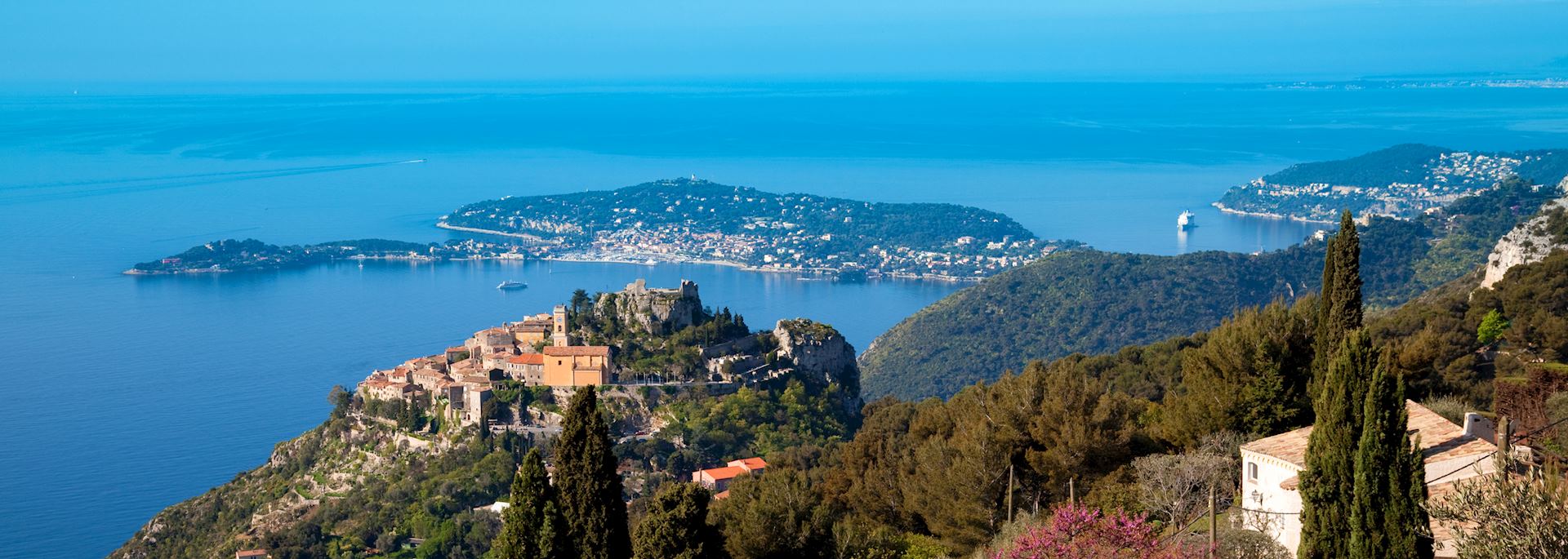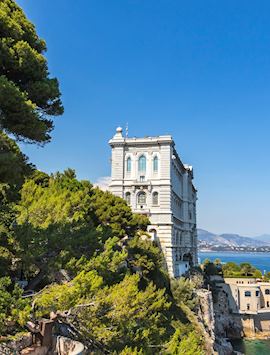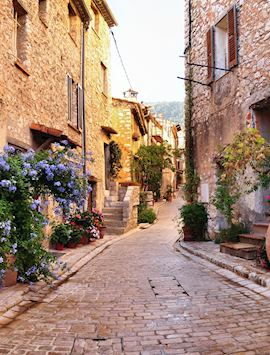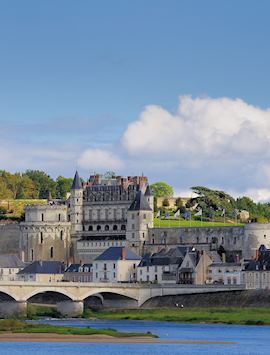By France specialist Aislyn
‘… in the shadow of the mountains a green belt of land runs along the coast for a hundred miles and makes a playground for the world.’ So said F Scott Fitzgerald of the French Riviera. Since the European aristocracy fell under the sway of the Côte d'Azur in the 19th century, its reputation as the place to be decadent has brought a succession of artists, writers, inter-war elites and modern-day glitterati to its resorts.
But if you look beyond the world of Dick and Nicole Diver, you can still glimpse a more authentic French Riviera. Away from the chic eateries, cafés still serve bowls of bouillabaisse, redolent with citrus and spices. In the hills of Grasse, you can visit a factory where perfume is made according to age-old traditions. And you can still find the tender, transparent light that attracted painters like Picasso and Renoir.
What to see and do on the French Riviera
Villa Ephrussi de Rothschild Saint Jean Cap Ferrat
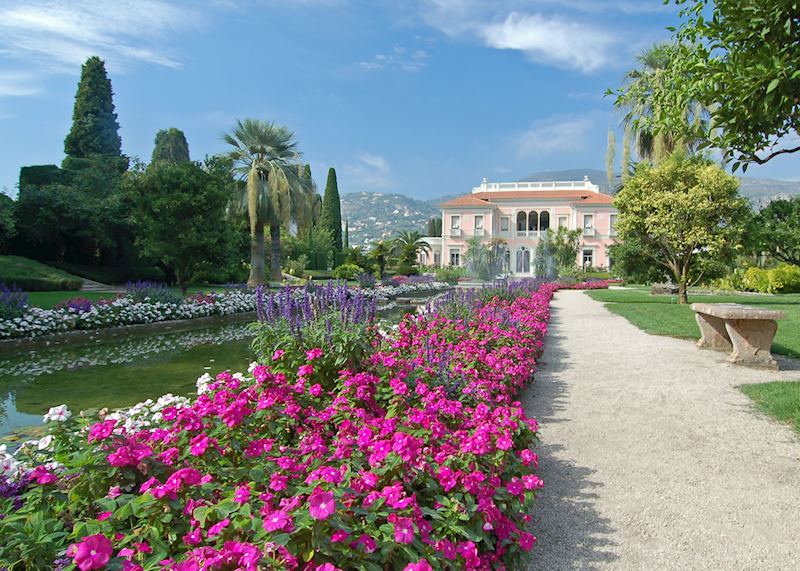
A rose-pink Belle Époque mansion that somehow always reminds me of a princess’s birthday case, Villa Ephrussi de Rothschild perches on a cape overlooking the Bay of Villefranche. It was built by Baroness Béatrice de Rothschild in the early part of the 20th century.
The cream-and-gilt interior features some of the Baroness’s extensive collection of artwork, including a ceiling painted by Giovanni Tiepolo, a table that once belonged to Marie Antoinette and a rug commissioned by Louis XIV, as well as the single richest collection of French porcelain in the world.
One of the most popular rooms is called simply ‘the patio’ — the name is perhaps the only example of understatement in the villa. Vast and sumptuous, with arched ceilings, marble pillars and an inlaid marble floor, the patio looks like a scene transplanted from a Renaissance palace in Venice.
However, I was more taken by the whimsical monkey room, named after the many mischievous creatures that populate the room’s decor, both painted on the wall panels and sculpted in Meissen porcelain. I spent a happy half hour seeking out images of simians engaged in all sorts of incongruous actions — juggling flames, skating and conducting an orchestra.
Outside, you’ll find nine gardens designed around various themes. The Japanese garden in particular drew me to its peaceful paths. After the hot bustle of the beachside towns, this cool, green space with a burbling koi pond made me slow down to listen to the quiet music of water trickling from a bamboo fountain.
Antibes and the Musée Picasso

In many ways, Antibes is like a microcosm of the Riviera. Flashy hotels and beautiful people preening in the sun dominate the coastline, especially around Port Vauban, which is the largest yachting port in Europe.
But just a few streets away from the beach bunnies you can find the old town. Here, cafés spill out into narrow cobbled streets and shoppers stroll through a covered market selling local produce.
The Commune Libre du Safranier, a semi-independent artistic community with its very own mayor, is arguably the prettiest section of town. Tall, narrow houses sport bright shutters, cascading flowers and potted citrus trees on their doorsteps, and housewives lean out of windows to have animated conversations cross the tight lanes.
The Saffarian community carries on a long tradition of creative sorts who’ve spent time in Antibes. Musicians like Cole Porter, writers like Graham Greene and painters like Max Ernst have worked and played here. F Scott Fitzgerald began writing Tender Is the Night in a rented villa on the periphery of Antibes, a thinly veiled account of his and wife Zelda’s own downwardly spiraling experience of life on the Riviera. But none of them are as celebrated at Pablo Picasso.
In 1946, Picasso took up residence on the top floor of the Château Grimaldi, a stern white-stone fort built into the old town’s fortifications. For half a year, in a studio that overlooked the sunlit sea, he produced a staggering array of work.
‘If you want to see the Picassos of Antibes, you must come to Antibes to see them,’ the artist once said. Those works, along with others donated by Jacqueline Picasso, are on display in the Musée Picasso, based in the chateau. It was a particular pleasure to see The Goat and La Joie de Vivre, the best-known paintings in this small, singular collection.
Monaco and Èze
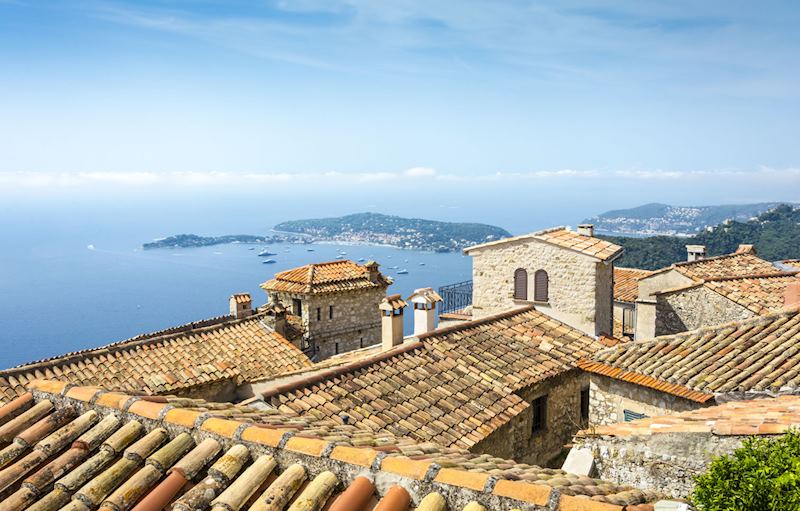
Playground of aristocrats, A-list celebrities, and high rollers, Monaco is the second-smallest state in the world, but it holds an outsized position in the minds of jet-setters.
Many of those who come here are drawn by the Casino de Monte-Carlo. This gilt-and-marble shrine to Lady Luck is a masterwork of elegance or ostentation, depending on your personal tastes. In popular fiction, the casino is often featured as a stylish setting for super spies and royalty.
During a recent tour of the casino (held every morning before the gambling begins), I learned more about the historical reality that fostered that reputation. Mata Hari herself slinked through the gaming halls here and Egypt’s King Farouk glutted himself on oysters while gambling away fortunes.
Just over the border, the village of Èze provides a sharp contrast to the glitz of Monaco. The medieval town clings precariously to the sides of a high peak overlooking the sea. The pedestrian-only streets spiral up the steep and stony slopes and then narrow down into alleys that wind between stone houses.
Once a fortress, these days the town is given over to boutiques, art galleries, cafés and restaurants. At its heart are the remains of a castle, built in the 12th century to take advantage of the strategic position provided by the high promontory. Louis XIV destroyed the castle in 1706 and, in the years following World War II, the ruins were turned into a garden.
The narrow brick paths of the Jardin Exotique d’Èze are lined with a diverse collection of succulents and cacti. The prickly residents create an alien-seeming landscape of bright-red flowers nestled amid sharp spines, tentacle-like waxy leaves and bristling sprays of blue-green grasses.
The garden also possesses some of the best views on the Riviera, encompassing the terracotta roofs of the town below, the port filled with tiny white sailboats and the far horizon where the endlessly blue Mediterranean meets the cloudless sky.
Paloma Beach, Saint-Jean-Cap-Ferrat
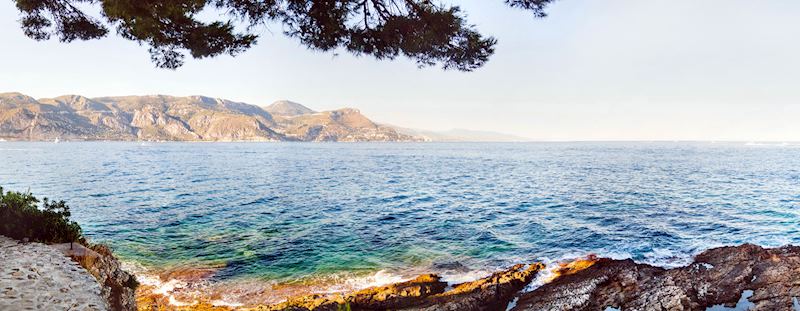
The pebbly cove of Paloma Beach in Saint-Jean-Cap-Ferrat — located at the bottom of a long set of stairs — is split between a public and private beach. It’s a far cry from big-name beaches like Cannes and Saint-Tropez. There’s a changing room for the public beach, but I prefer to use the restaurant and have access to a cabana and shower as well.
The water off Paloma Beach, as with almost everywhere on the Riviera, is serene and blue, and on a hot day it’s a lovely place to swim, paddleboard or dive. French beachgoers have a very casual attitude toward nudity and you’ll often see topless women sunbathing both here and on other beaches.
It’s hard to appreciate the beauty of the coastline fully when you’re on the beach, so last time I visited the French Riviera, I took an evening cruise along the shore. The captain steered the private vessel, equipped with a bucket of well-chilled Champagne, through the azure waters along the jagged shore. The slanting golden sun picked out the sharp peaks of houses, lit up the billowing sails of the nearby boats and threw the feathery fronds of the palm trees into high relief.
Off the beaten path on the French Riviera
Parfumerie Fragonard, Grasse

Filled with gleaming copper vats, swan-necked stills and rows of brown glass bottles sporting faded labels, the Fragonard Musée du Parfum looks like an alchemist’s lab from some Victorian pulp story.
It’s an apt comparison. In the Parfumerie Fragonard, and in many factories around the town of Grasse, the workers do perform a sort of alchemy. They take ingredients from around the world, including baskets of flowers and mounds of citrus peel, and transform them into precious elixirs. This has been the perfume capital of the world for more than a century.
I visited the museum located in the Parfumerie Fragonard, a stucco building painted a warm Provençal gold and graced with white shutters. Inside, the tour starts with a scent-matching game in which players sniff samples and guess the source — jasmine, violet or the ever-present lavender.
I thought I’d done fairly well by identifying seven of the ten different smells. Then I learned that the masters of perfume who train in Grasse can identify a mind-boggling 2,000 different scents. These remarkable people are known in the industry as les nez (the noses).
The tour explains the millennia-long history of perfume making and some of the production methods — traditional and modern. I watched the workers unfurl paper filters, like giant white flowers, into conical sieves to strain decoctions made from tons of flower petals.
What to eat and drink on the French Riviera

Thanks to the bountiful waters of the Mediterranean and the plentiful sunshine of Provence, the cuisine of the Côte d'Azur is rich with seafood, fresh vegetables and citrus fruits.
Menus feature whatever fish is abundant, from white fish like sea bream to small, oily fish like anchovies. Regardless of the time of year, chefs usually handle the fish with a light touch, letting the briny taste and delicate texture of the flesh shine through.
The bold sea tastes of the region are perhaps best captured in bouillabaisse, the storied fish stew of Provence. A base made of fresh tomatoes, citrus, fennel and garlic is first briskly boiled with various fish into an emulsified sauce then slowly simmered. The precise nature of the fish that go into the pot is a hotly debated topic, but most cooks will acknowledge that spiny rascasse is essential.
Bouillabaisse is usually served with toasted bread spread thickly with rouille, an unctuous garlic-spiked aioli that is tinged with golden saffron and includes enough red pepper to set your mouth tingling. The rich sauce is powerful enough to stand up to the big tastes of the fish stew.
Another popular sauce in the region is pistou, which is closely related to the Italian pesto and is a key ingredient in soupe au pistou. The simple bean and vegetable soup is traditionally served with a generous dollop of pistou in the middle — bright basil green and glistening with olive oil — which you’re encouraged to swirl into the broth.
Olives are a staple here and you can find them almost everywhere — being sold in small bags at market stalls, in salade niçoise and in tapenade. Made of finely chopped olives, briny capers and olive oil, tapenade is a powerful condiment that goes equally well with tangy chèvre or roasted lamb or simply dabbed on a slice of bread.
You can find any sort of wine in the plethora of high-end restaurants along the coast, but the local vineyards primarily produce rosés. Generally, regional wines are zesty and refreshing, with more than a hint of strawberries or raspberries.
The region is also known for pastis, an apéritif made with anise seeds. The transparent golden drink turns opaque and chartreuse when it’s watered down, which is how I prefer to drink it. Even diluted, the spirit packs a bit of a wallop.
There is no real off-season on the French Riviera. It’s almost always sunny, blessed with an average of 300 days of clear blue skies every year, and there’s a year-round calendar of festivals and events. Some of those draw people from around the world — Festival de Cannes or the Monaco Grand Prix — which causes the heavy traffic to grind to a standstill. If you’re not visiting specifically to attend the events, you may want to avoid them.
Visits in May and June, as well as September and early October allow you to enjoy the beaches without throngs of visitors. Winter is sunny and mild, with comfortable temperatures, if you aren’t interested in swimming. The heat and crowds reach their peak during July and August.
Where to stay on the French Riviera
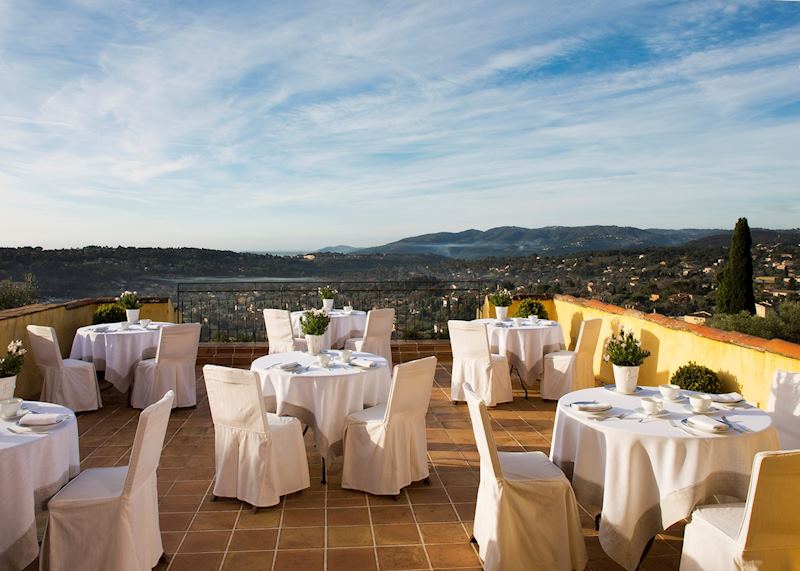
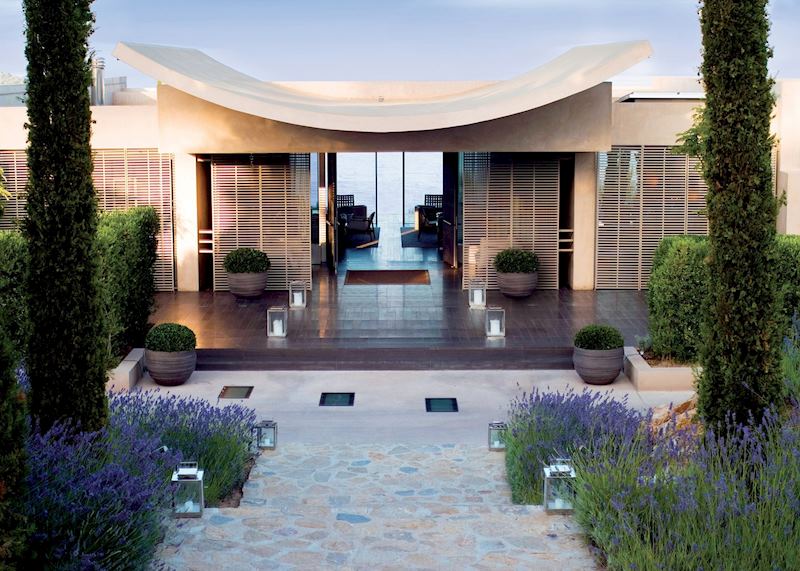
Nestled the heart of a venerable olive grove, La Bastide Saint-Antoine is an elegant retreat in Grasse. The hotel is perched on top of a hill and many of the elegantly appointed rooms overlook the manicured grounds and the valley below. In season, the Michelin-starred restaurant serves meals on the garden terrace.
To enter La Réserve Ramatuelle, a spa and hotel in Saint-Tropez, you have to go through a giant wrought iron gate that swings open slowly. Passing through, you enter a serene retreat where all your needs are anticipated by a host of smiling staff.
Rooms are enormous, with a minimalist decor that focuses all your attention on the view of the sea out of the floor-to-ceiling windows. Eleven spa rooms provide cutting-edge treatments as a corrective if you have overindulged in the pleasures of the Riviera.
Best time to visit the French Riviera
There is no real off-season on the French Riviera. It’s almost always sunny, blessed with an average of 300 days of clear blue skies every year, and there’s a year-round calendar of festivals and events. Some of those draw people from around the world — Festival de Cannes or the Monaco Grand Prix — which causes the heavy traffic to grind to a standstill. If you’re not visiting specifically to attend the events, you may want to avoid them.
Visits in May and June, as well as September and early October allow you to enjoy the beaches without throngs of visitors. Winter is sunny and mild, with comfortable temperatures, if you aren’t interested in swimming. The heat and crowds reach their peak during July and August.
Start planning your trip to the French Riviera
Start thinking about your experience. These itineraries are simply suggestions for how you could enjoy some of the same experiences as our specialists. They're just for inspiration, because your trip will be created around your particular tastes.
View All Tours in France
